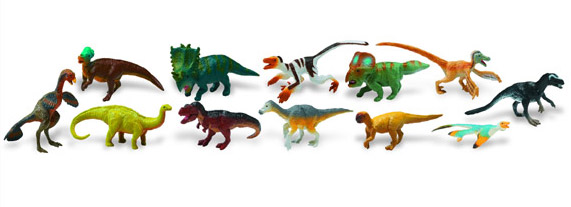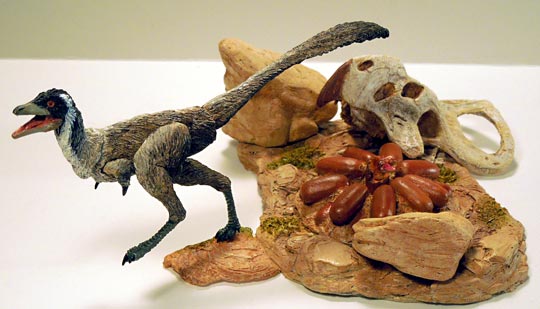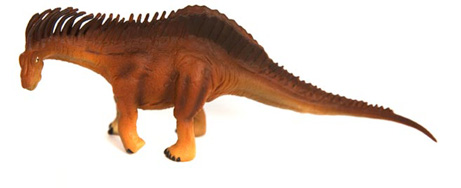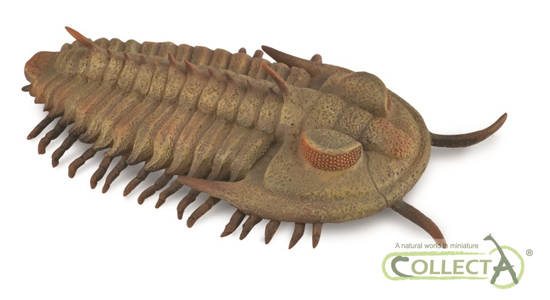Examination of Hadrosaurine Stomach Contents
Occasionally an animal is so well preserved that extraordinary amounts of information can be gleaned from the fossil. One such example is the wonderfully well preserved fossil of a duck-billed dinosaur from the Judith River Formation of Montana, USA.
An analysis of the probable gut contents from this fossilised dinosaur reveal that its diet at the time of its demise consisted mainly of leaves. The leaves had been well-chewed, with many of the pieces less than 5 mm in size.
Brachylophosaurus
The fossil is of a hadrosaurine duck-billed dinosaur called a Brachylophosaurus (Brachylophosaurus canadensis) an immature sub-adult that would have grown to a length in excess of 7 metres – not bad on a diet made up of leaves. This dinosaur fossil, in common with a number of other articulated specimens has been given a nick-name. It is known affectionately as “Leonardo” although the sex of the animal is unclear. The Brachylophosaurus got this nickname as when the fossil hunting expedition found it in the summer of 2000, close by carved on a rock was some graffiti – “Leonard Webb loves Geneva Jordon 1916”.
The fossil record indicates that brachylophosaurs were relatively rare compared to other hadrosaurine hadrosaurs. Only a few specimens have been found compared to the many hundreds of fossils of other hadrosaurs found in Upper Cretaceous strata of the Western USA and Canada.
Brachylophosaurus means “short-crested lizard”, the crest implied in the scientific name consisted of a flat plate on the top of the head. This duck-billed dinosaur did not have much of a duck-bill either, rather than the typical broad duck-like bill of a typical hadrosaur, the horny beak of Brachylophosaurus was down-turned and flattened from side to side. Perhaps this is indicative of an adaptation for a particular type of browsing or other feeding behaviour. Further analysis of the gastric tract may provide more information about the type of plant material this animal ate.
Other dinosaur fossils have been analysed to establish diet, but finding fossil evidence of this nature is extremely rare. The analysis of the gastric tract was carried out by Justin Tweet, a graduate student at the University of Colorado, working in conjunction with other students and supervising palaeontologists.
Hadrosaurine Stomach Contents
The team focused on trying to analyse the constituents of the fossil in the area believed to represent the gut of the animal. Microscopic study identified quantities of pollen, this could then be examined to reveal the types of plants this dinosaur had been eating. Although pollen grains are very small, they are abundant and exceedingly resistant to decay. Fossil pollen grains can be released from rock by dissolving the matrix in hydrofluoric acid. This powerful acid, in a high concentration is capable of etching glass, but the fossilised pollen survive this process and can be studied to indicate the plants that were being eaten, as different plants have different shaped and sized pollen grains.
It seems that “Leonardo” had grazed on a variety of plants including flowering plants and ferns. Pollen could also enter the gut if it had been ingested as the animal drank, and indeed there are other contaminants associated with this particular fossil. Only about 12% of the fossil material studied is organic, the rest is clay and grit, which possibly entered the animal’s digestive tract as the body was covered, or perhaps this indicates that Brachylophosaurus was a low browser and picked up soil and other debris as it pulled out plants with its strong jaws, although the relatively high concentration of inorganic matter would cast doubt on this theory – surely this dinosaur was not that messy an eater!
The dentition of these dinosaurs is very formidable with rows of self-sharpening teeth and a jaw mechanism that allowed the tooth surfaces to grind together, an excellent way to break down tough vegetation. With the plant matter partially broken up this was then swallowed and the strong acidic gastric juices and microbes inside the gut would have continued the digestion process.
In the picture above, the rib bones can be made out along with impressions of the dinosaur’s skin. Much of the skin of this dinosaur is also preserved, and this has revealed more information about Brachylophosaurus and its way of life. The skin around the shin and ankle is especially thick, perhaps acting as protection as the animal made its way through the undergrowth.
The discovery of “Leonardo” has certainly helped palaeontologists learn more about this unusual dinosaur, even gaining an insight into its diet. It also led to the discovery of another hadrosaur fossil in the same location, when a media co-ordinator found a new fossilised dinosaur at Leonardo’s site when rehearsing a visit to view the excavation of the original specimen.
To read an article about this second discovery: Media co-ordinator discovers dinosaur!
Leonardo will be put on display shortly at the Houston Museum of Natural Science in a special exhibit entitled “Dinosaur Mummy C.S.I. (Cretaceous Science Investigation), a homage to the popular U.S. TV franchise C.S.I. about forensic teams helping to solve crimes.
Ironically, for a Late Cretaceous dinosaur believed to be somewhere around 80 million years old, there was a delay of one week before the exhibition could start. Power cuts caused by hurricane Ike had were the reason for the delay, but fortunately none of the precious museum specimens were damaged.
Members of the public will be able to see this remarkable fossil for themselves and discover more about the on-going research surrounding this superbly well-preserved specimen. Scientists have suggested that the fossil evidence indicates a diet of leaf matter, almost the title of Lynne Truss’s book about having a zero tolerance to punctuation.
Here is a dinosaur the eats shoots and leaves, leaving us evidence of its diet in the fossil record.
Everything Dinosaur supplies a wide range of hadrosaurine dinosaur models from the figures and replicas section of its award-winning website: Dinosaur and Prehistoric Animal Models.











